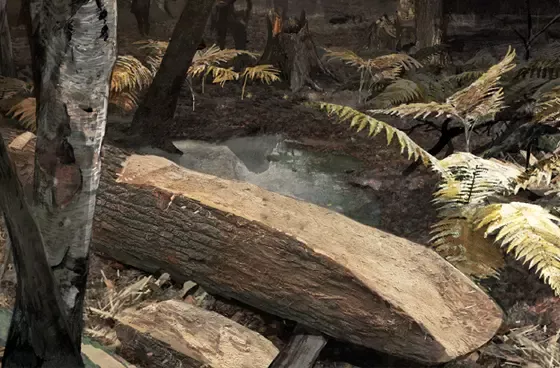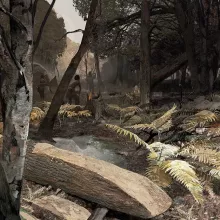
The first major experiment within the project Putting Life into Late Neolithic Houses: studying domestic craft and subsistence activities through experiments and material analysis was the making of a dugout. The vessel was constructed by the Masamuda volunteers under the supervision of Leo Wolterbeek and took a little over a year to complete (click here for more). This experiment resulted in a beautiful visualisation by Kelvin Wilson.
This visualisation (see full image below) is based on archaeological data and the practical knowledge of the team members of the project and based on countless discussions. The reasoning behind the choices made is outlined in the text below.
All copyright resides with Kelvin Wilson and the University of Leiden.

Our reasoning:
- We selected an oak for the construction, based on a dugout found in wetland conditions at Wieringermeer;
- Oak trees of the length and straightness required for making a dugout this length (about 5.5 metres) would not grow on the coastal dunes nor on the levees, but only further inland;
- To obtain an oak tree without side branches (and thus knots) the tree would have had to grow in the midst of other trees so that it would grow straight to the light;
- The fact that this type of tree was not locally available to the inhabitants of the coastal sites, meant they had to travel inland to obtain such a tree;
- We decided not to use fire to make the dugout because we think oak is not suitable for this (unlike several hardwoods used in other regions across the globe), and because there was no evidence for the use of fire on the original dugout. We only used polished flint axes and adzes, bone and antler wedges and wooden billets.
- Our experiments have shown that making a dugout like this takes about 3-4 weeks of work by about four people;
- This led us to propose that a small group would have travelled inland along the waterways, making use of the tide and occasionally towing the vessel;
- Having to spend several weeks near the dugout production place implied having to set up a camp and creating some sort of dwelling;
- We reasoned that late autumn would be the best moment for this expedition as it would give the possibility to hunt for example fur animals. This season would also not interfere with agricultural activities;
- While some were working on the dugout, children and other members of the party could collect nuts, mushrooms, roots and fruits for storage in the winter.

Our questions:
- What do you think of the argumentation above and the choices we made?
- Is the autumn a reasonable time to make a dugout?
- Do you have other ideas about the time and labour it requires to make a dugout of this size based on your experience?
- Could the coastal inhabitants maybe rather have acquired such a dugout from people living further inland for whom it may have been easier to produce it? In other words, was the dugout maybe an object of exchange?
- Have you found evidence for such temporary camps as proposed in this visualization?
- Could this trip be part of a system of social networks in the context of which the coastal people could also have obtained flint, as much of the flint found at Vlaardingen sites is of southern origin (Hesbaye, Spiennes) and possibly even canoes?
- Has anyone tried making a dugout of oak using fire? And if so, did this work well in your experience?

This project is funded by the Dutch Research Council NWO (AIB.19.020).

